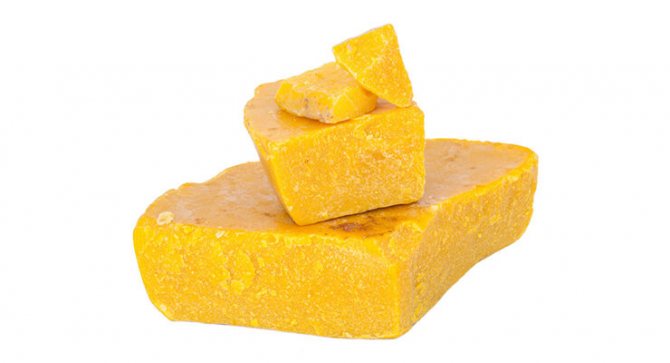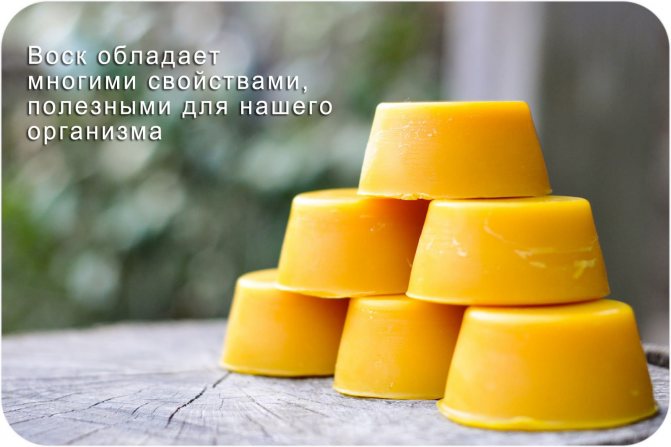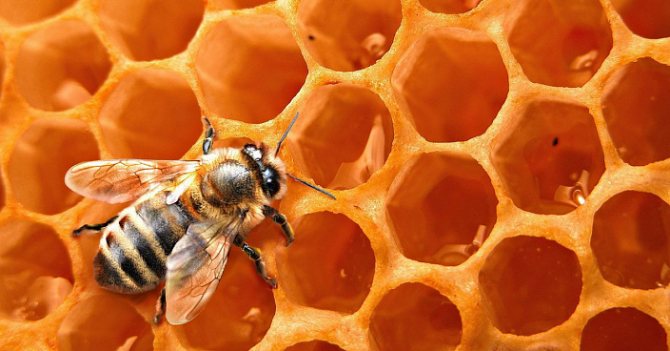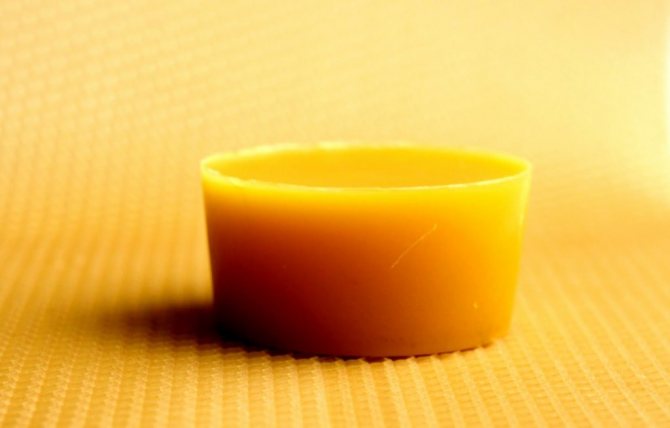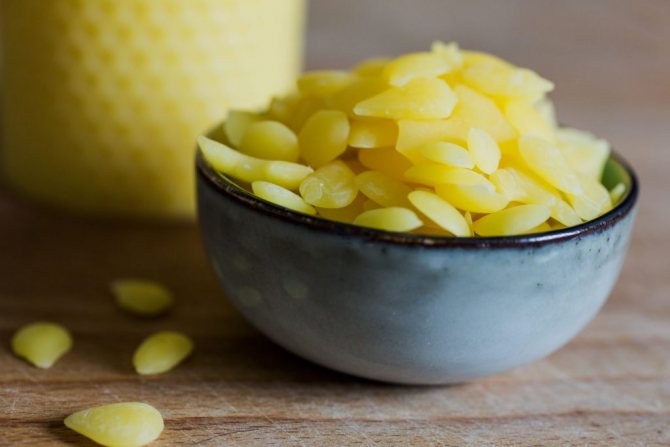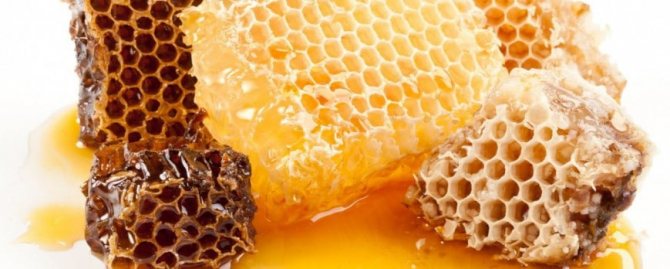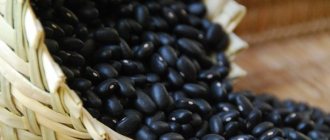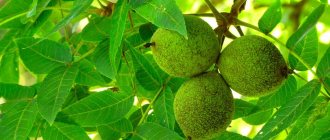Greetings to all readers of the article. Today we will talk about a unique beekeeping product, the benefits of which exceed all reasonable limits.
Wax is the most useful substance for humans, also called ceresin. It has a complex chemical composition and has been used by people for hundreds of years. Due to its many medicinal properties, ceresin has received close attention from doctors and cosmetologists. Also, it is used in domestic industries.
Beeswax - beneficial properties and uses
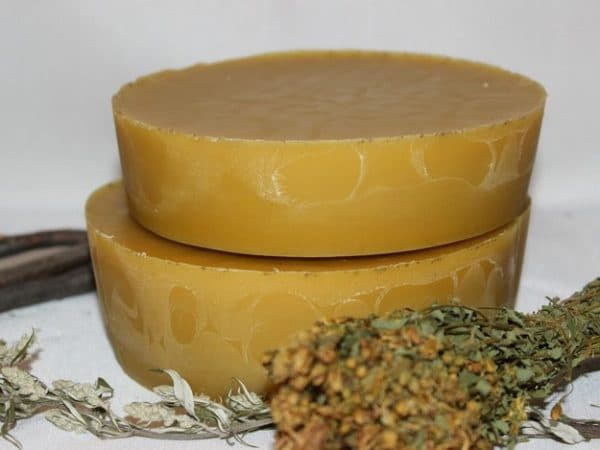
The wax is produced by glands located on the abdomen of bees. It, like honey, contains many vitamins and minerals useful for humans.
This product is used for a variety of purposes:
- to kill germs in the mouth like chewing gum;
- for the preparation of medicinal and cosmetic ointments;
- for wraps;
- for the treatment of joint diseases;
- to rejuvenate the skin of the face and body.
Useful composition
It contains the following substances:
- palmitic acid myricyl ester;
- unsaponifiable hydrocarbons;
- normal alkanes, etc.
It is known that wax has antimicrobial, healing and disinfecting properties.
Physical properties
An interesting feature of wax is its durability, without loss of quality it can be stored for thousands of years. When hitting a wax ingot with a hammer, it breaks into small pieces with a fine-grained structure at the fracture.
The ingot has a smooth, shiny and uniform surface, it is resistant to moisture and light, and is insoluble in water. Mohs hardness less than 1.
The color of the wax is from white with a yellowish tinge to yellow-brown, it can change under the influence of sunlight. The smell is pleasant, honey. The propolis admixture imparts a greenish tint. At body temperature (+36 ° C) the wax becomes plastic and melts at +63 ° C.
Storage rules
Wax is a very persistent product. It is not hygroscopic, does not lend itself to oxidation by atmospheric oxygen, does not dry out, and therefore does not lose weight, is inert to the effects of various microorganisms. At the same time, it is able to absorb various odors and is a favorite food of mice, rats and wax moth larvae.
Therefore, it must be stored in a wooden container in a clean room, inaccessible to pests, without strong odors. The temperature is above zero, but not more than 20 degrees C. Shelf life is unlimited.
Can you eat beeswax?
In the stomach and intestines of a person, wax is not digested. It can be swallowed in small amounts while eating honeycomb. Small wax particles will cleanse the body of microbes and toxins, will have a healing, beneficial effect on the gastric mucosa.


Be sure to read:
Do-it-yourself wax melter at home: purpose, types, how to make
The volume of eaten wax honeycomb should not exceed 1-2 teaspoons per day. A large amount of this product can lead to unpleasant consequences - heaviness and pain in the stomach, indigestion.
Beware of counterfeits!
In the market or in a store, unscrupulous sellers can sell a synthetic version of wax to an inexperienced buyer. Where to get natural beeswax? Trusted honest beekeepers.If there are none in your environment, there are several signs of a natural product:
- The surface is matte on the cut
- The smell is light, honey
- The consistency is firm
- Color from light yellow with a pink tint to dark yellow
- The melted piece of wax should not change its color.
Read also: The drug "Bipin-T" (1 ml): instructions for use, composition
All the waste products of hardworking bees benefit humans. Beeswax is no exception. It is quite simple to use it, remembering its main properties:
- Wax is a natural preservative, antibiotic, natural antimicrobial agent and sorbent
- Wax mixes well in liquid form with vegetable and animal fats, but does not dissolve in water, glycerin or alcohol
- The wax is melted in a water bath in order to preserve its properties as much as possible.
I wish my readers to try and love this product, as well as actively use it for the benefit of their health!
What can be made from beeswax?
Beeswax is one of the food additives. It is used to coat cheeses, sausages, sweets and pastries to prevent spoilage.
The scope of this product is very wide:
- It is used in the processing of wood products to give them shine and durability.
- It is added to various home care products for shoes and leather clothing.
- Candles are made.
- Used in cosmetology and medicine.
- Various creams and lipsticks are made on its basis.
- Healing ointments are prepared.
How to be treated
In medicine, wax is used in many methods of complex therapy to alleviate the symptoms of diseases.
The use of its biologically active substances is beneficial in:
- Traditional medicine;
- Dentistry;
- Dermatology;
- ENT therapy;
- Dietetics ;;
- Surgery for burns.
A large number of recipes based on the properties of wax have been used during the period of gestation to normalize lactation. Methods for increasing immunological resistance and resistance to diseases are also popular.
In treatment:
- Is taken orally;
- Topically as compresses, applications;
- Outwardly: is the basic component of creams, ointments.
Using beeswax: recipes
A base cream is made on the basis of wax, which has a healing effect on the skin. In addition, it protects against dirt and harsh environmental conditions. On the basis of the base cream, various medical and cosmetic compositions are created.
Ingredients for the base ointment:
- olive oil - 1 l;
- wax - 100 grams.
Manufacturing and application:
- Mix the components.
- Heat in an enamel bowl using a water bath. When it cools, you should get a thick, soft ointment.
Any vegetable oil will work for the recipe. This ointment is absorbed into the skin and leaves no residue. To enhance the healing properties, various components are added to it: dead bees, moth, aloe juice or chicken yolk.
Contraindications
Contraindications to the use of yellow secretion arise only with personal intolerance to the product. Before using medicinal ointments and oils based on beekeeping products, it is recommended to consult a specialist. A natural wax-containing preparation should be used only after establishing the safety of such measures and the absence of an allergic reaction.
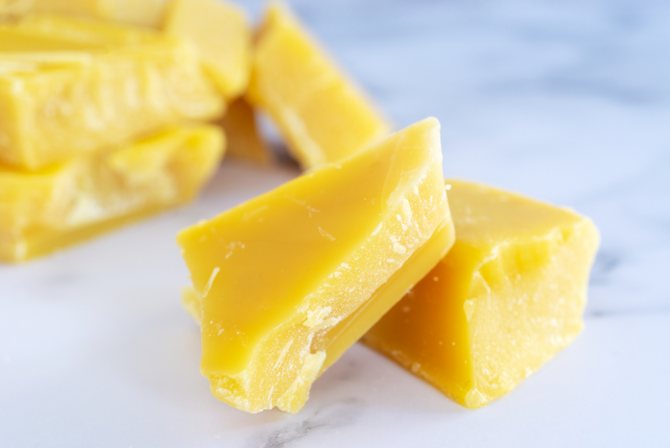

As such, there are no contraindications, except for personal intolerance, the bee's secret - the benefits and harms of the substance from the use are not comparable. It is possible to use wax-containing preparations without fear and risk, but it is recommended to start with small doses. If we talk about creams and oils, first you need to apply a small amount of the product to the skin, and follow the reaction. If negative consequences have not appeared, the cream can be used without fear.
Home use
The wax contains many useful components, thanks to which it has a healing effect when applied externally and internally. For healing and cosmetic purposes, it is best to buy light, yellow wax ingots.
Even more appreciated is the backing - stripping from frames, ceilings, bars, in which the larvae of bees were not grown. It is used to prepare anti-aging and cleansing creams for face care.
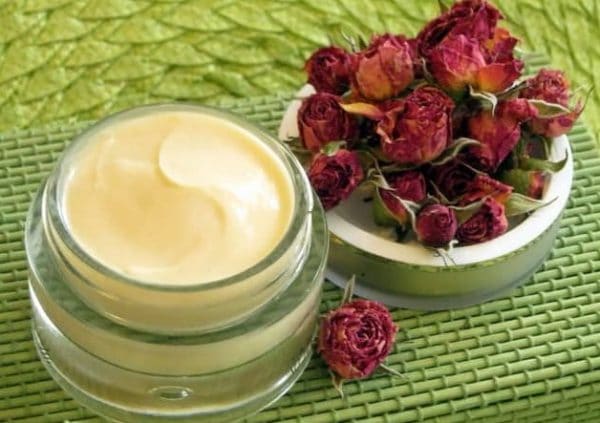

The antibacterial properties of wax inhalations are used during seasonal colds, chronic bronchitis or acute tonsillitis. Honeycombs are chewed to clean teeth, cure periodontal disease, sinusitis, tonsillitis and gastrointestinal diseases.
Healing ointments are prepared for sore joints, treatment of wounds, burns, allergic skin irritations, and strengthening of nails. Wax wraps have a warming effect, cleanse the skin of toxins, smooth wrinkles, and relieve inflammation.
Topical treatment with beeswax: 4 recipes
An ointment based on beeswax is used for sinusitis, mastopathy, joint pain, burns, skin inflammation and other diseases.
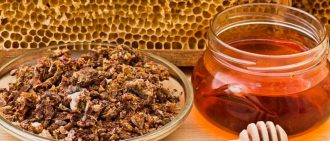

Be sure to read:
What is bee propolis: what it consists of, how to use it, what it helps
Bee venom ointment for sore joints
Ingredients:
- base ointment - 1 l;
- dead bees - 1 tbsp.
Manufacturing and application:
- Wax ointment with olive oil is heated in a water bath.
- A glass of dry bees ground in a coffee grinder is poured into it.
- Cook for 30 minutes with the lid closed, stirring regularly.
- After removing from heat, filter through cheesecloth.
- Apply to sore joints daily at night for a month.
Healing propolis cream
Ingredients:
- olive oil - 1 l;
- propolis - 100 g;
- wax - 50 g.
Manufacturing and application:
- In a water bath in an enamel container, heat the oil, put a piece of wax.
- When it melts, crumbled propolis is added.
- Cook for 30 minutes. with a closed lid.
- Before applying the cream, check if there is any allergy to propolis.
The ointment is used for many diseases: psoriasis, hemorrhoids, fungus of the skin and nails, bedsores, bacterial rhinitis, age-related skin changes.
External use should be long-term, at least a month. The number of treatments per day - at least 2 times (morning and evening).
Ointment for external use for rheumatism


Ingredients:
- flaxseed or any other vegetable oil - 150 ml;
- wax - 25 g;
- boiled chicken yolk - 0.5 pcs.
Manufacturing and application:
- Knead the yolk thoroughly with a fork.
- In an enamel container on a water bath, bring the oil to a warm state. It is impossible to boil the mixture so that it retains its beneficial properties.
- When the oil is heated, wax is added to it in small pieces, dissolved with stirring.
- Pour in the yolk, beat with a whisk.
- Filter the mixture through a sieve into a clean glass container, rubbing the rest of the yolk.
Stored in the refrigerator for up to 3 months, used every day.
Rejuvenating cream
Ingredients:
- olive oil - 200 ml;
- coconut oil - 100 ml;
- beeswax - 100 g;
- vitamin E in oil - 1 tsp;
- essential oil - 40 drops.
Manufacturing and application:
- The wax with coconut and olive oil is melted in a water bath.
- Set aside to cool, stirring all the time.
- Vitamin E and essential oil are added to the cooled cream.
- Apply to the face, décolleté, hands at least 1 time daily, in the morning.
The cream helps to restore elasticity and softness to aging skin. The treatment lasts 1-2 months. It is advisable to carry out several courses of anti-aging cream therapy during the year.
Use in cosmetology
Various procedures are performed in beauty salons - waxing, body wraps, cleansing masks. The bee bar is added to natural high-quality cosmetics for skin and hair care. You can make your own facial treatment at home.
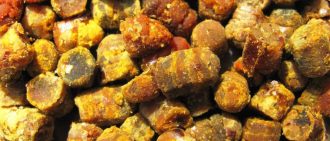

Be sure to read:
What is bee bee: composition, how to take it correctly, contraindications
Cosmetic cream for daytime skin care
Ingredients:
- base ointment - 100 g;
- royal jelly - 1 g.
Manufacturing and application:
- Royal jelly is added to the cooled oil with wax.
- Mix everything well.
This cream should be used within 6 months and kept in the refrigerator.
Flame Night Cream
Components:
- olive oil - 1 l;
- wax - 100 g;
- moth - 1 tbsp.
Manufacturing and application:
- When heating oil and wax on a steam bath, add dry, ground fire.
- Keep on fire for 30 minutes. with a closed lid, filter.
This cream helps to get rid of wrinkles, scars, various skin problems.
Beeswax inhalation: 3 recipes
In case of a sore throat, bronchitis, sinusitis, tonsillitis, sinusitis, it is recommended to do medical wax inhalations.
Prescription for chronic bronchitis and sore throat
Ingredients:
- propolis - 40 g;
- wax - 60 g.
Preparation and application:
- The components are melted in a water bath.
- Vapors are inhaled through the tube in the morning and in the evening for 10 minutes.
Dry inhalation for colds
What they do:
- 50 g of wax is heated to 40 degrees.
- Roll out into a cake.
- Healing vapors are inhaled for 15 minutes at night.
- Repeat the procedure daily for a week.
Recipe with propolis and essential oils to treat throat and bronchi
Ingredients:
- propolis - 40 g
- wax - 60 g;
- eucalyptus oil - 5 drops.
Preparation:
- The mixture of components is melted in a water bath.
- Breathe in pairs through the tube gently so as not to burn yourself.
- The procedure is repeated daily for 15 minutes for a week.
Chemical composition
The positive effects of beeswax are due to its rich chemical composition. Let's consider the main components of which it consists:
- Alcohol.
- Organic acids.
- Fatty acid.
- Paraffinic carbohydrates.
- Resins.
- Polymer fats.
- Vitamin A.
- Propolis.
- Bee pollen.
If beeswax is heated to a temperature above 100 degrees, many substances evaporate and the product loses many useful properties. If you melt it yourself, then you need to use a container made of steel or aluminum.
The benefits and harms of beeswax
Beeswax, Is a unique product with healing properties.
With its help, many diseases are treated:
- arthritis, arthrosis, rheumatism;
- skin rashes;
- burns, wounds, trophic ulcers;
- inflammation of the oral mucosa, periodontal disease:
- colds, bronchitis, tonsillitis, sinusitis;
- gastrointestinal diseases, poisoning;
- otitis media, headaches, etc.
Wax can only be harmful if you are allergic to it. This rarely happens.


